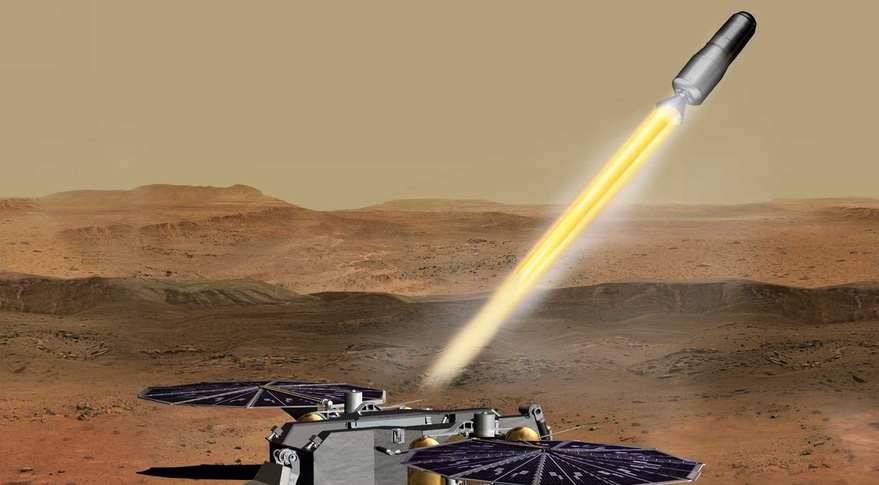WASHINGTON — NASA plans to delay the next phase of its Mars Sample Return campaign and split a lander mission into two separate spacecraft to reduce the overall risk of the program.
At a March 21 meeting of the National Academies’ Space Studies Board, Thomas Zurbuchen, NASA associate administrator for science, revealed that NASA and the European Space Agency had agreed to revise the schedule and design for upcoming missions that will return samples being cached by the Perseverance rover to Earth.
Original plans called for the launch of both a NASA-led Sample Retrieval Lander and ESA-led Earth Return Orbiter in 2026. The lander, using an ESA-built rover, would collect the samples cached by Perseverance and load them into a rocket called the Mars Ascent Vehicle (MAV), which would launch them into orbit. The orbiter, using a NASA-provided collection system, would gather the samples and return them to Earth in 2031.
An independent review, though, recommended in November 2020 that NASA delay those future missions to 2027 or 2028 to provide a more reasonable development schedule. Another panel recommendation was for NASA to investigate turning the single Sample Retrieval Lander spacecraft into two separate landers, one carrying the rover and the other the MAV.
Zurbuchen told the Space Studies Board that NASA and ESA had agreed to split the Sample Retrieval Lander into two landers, which would now launch in 2028. “The Phase A analysis demonstrated that, frankly, the single lander breaks entry, descent and landing heritage. It is actually high risk,” he said.
The single-lander approach would require a larger heat shield, estimated to be 5.4 meters in diameter, which in turn would require a larger payload fairing for the rocket launching it. The design also had “unproven” entry, descent and landing capabilities and would require electric propulsion on the cruise stage to increase its payload performance.
A dual-lander approach, he said, could make use of the same landing system used by Perseverance and, before that, Curiosity. “It can be completed in the ’20s, just like we want to,” he said, and avoids the complexity of the larger design.
Both NASA and ESA agreed to adopt the approach as well as a schedule that would delay the launches of the two landers to 2028. The Earth Return Orbiter would launch in 2027, and the samples would return to Earth in 2033 under that revised schedule.
Zurbuchen said one lander, dubbed SRL1 and carrying the MAV and a robotic arm for sample transfer, would be built by the Jet Propulsion Laboratory because of “criticality and integration.” NASA had not yet decided on who would build the second lander, SRL2, which will carry the fetch rover. The decision, he said, would come by June, when the mission reaches a programmatic milestone called Key Decision Point B.
He did not discuss the cost implications of the schedule or design changes. Shortly before the launch of the Mars 2020 mission carrying the Perseverance rover, NASA and ESA officials estimated that the overall Mars Sample Return campaign would cost at least $7 billion. NASA will not make formal cost estimates of its future lander missions until the later Key Decision Point C review, although the agency’s fiscal year 2023 budget proposal, due for release March 28, may contain some additional details.
A complicating factor for Mars Sample Return plans is the delay in ESA’s ExoMars rover mission, which was to launch in September until the agency suspended its partnership with Roscosmos earlier this month after Russia’s invasion of Ukraine. ESA is now considering options for going forward with the mission that would delay its launch to at least 2026.
ESA officials said March 17 that those options could include a renewed partnership with NASA. Zurbuchen alluded to those comments in his remarks at the meeting but did not elaborate on any NASA role in ExoMars. “We are having a lot of discussion with our European colleagues that may or may not affect some of the discussions here related to ExoMars,” he said. “It’s up to them to talk about that.”
